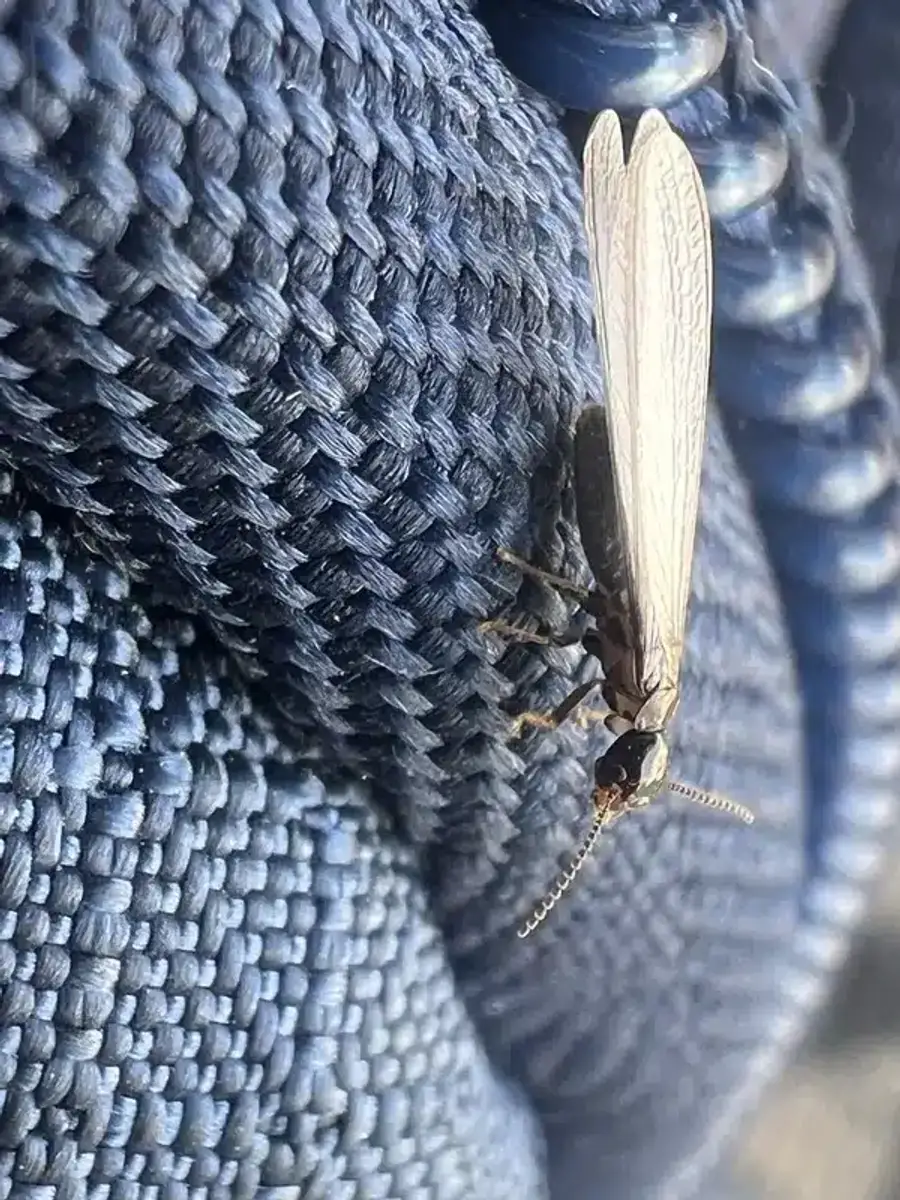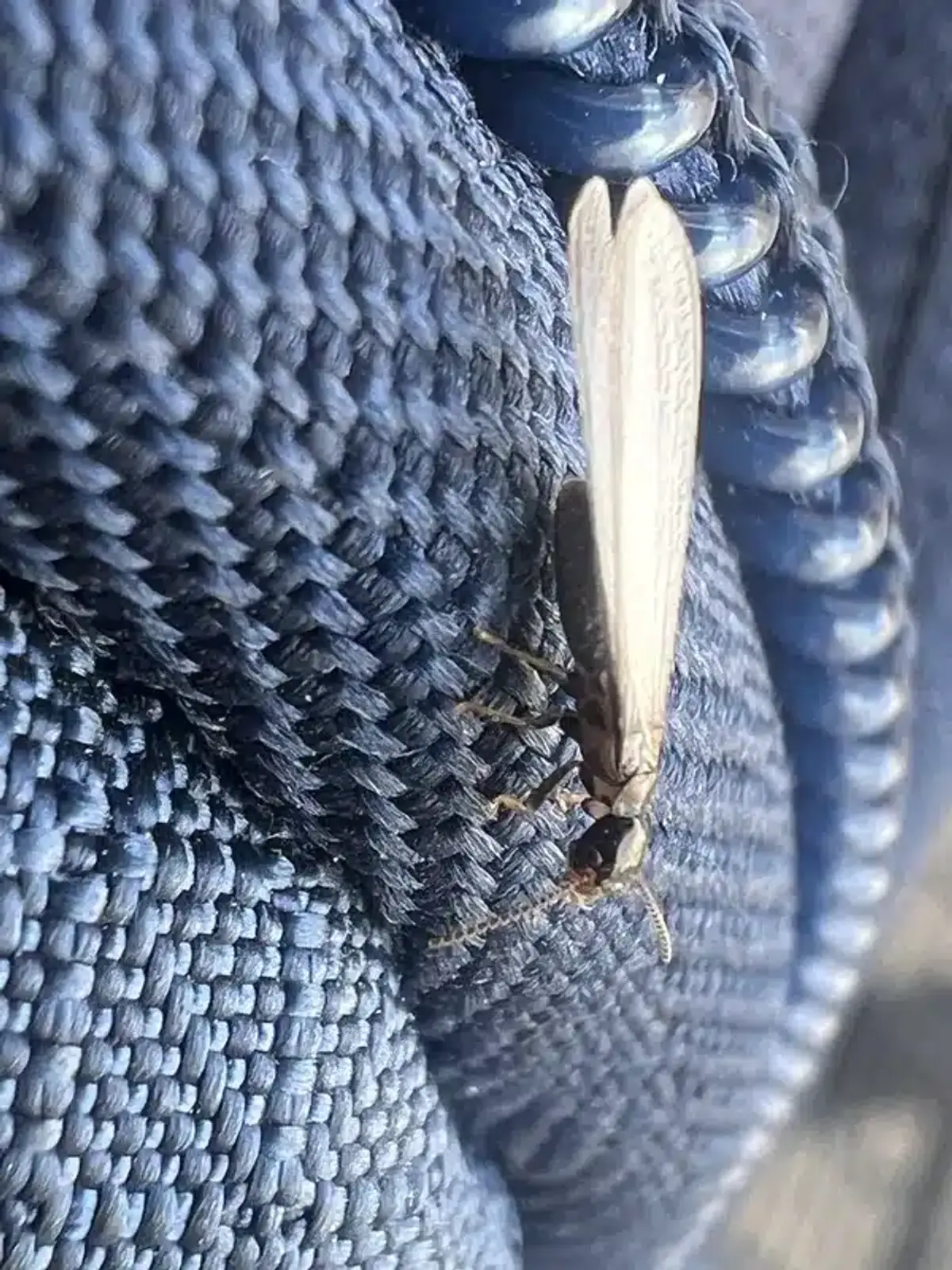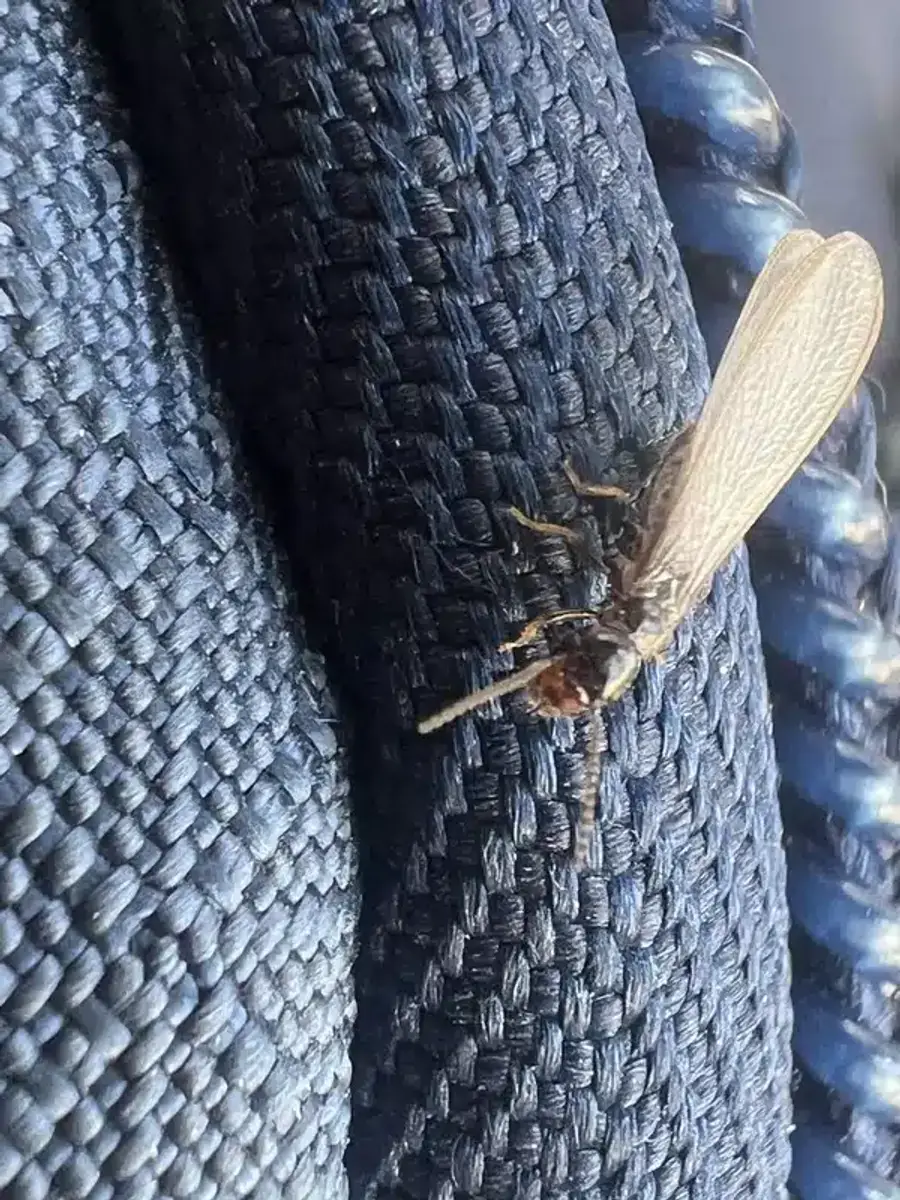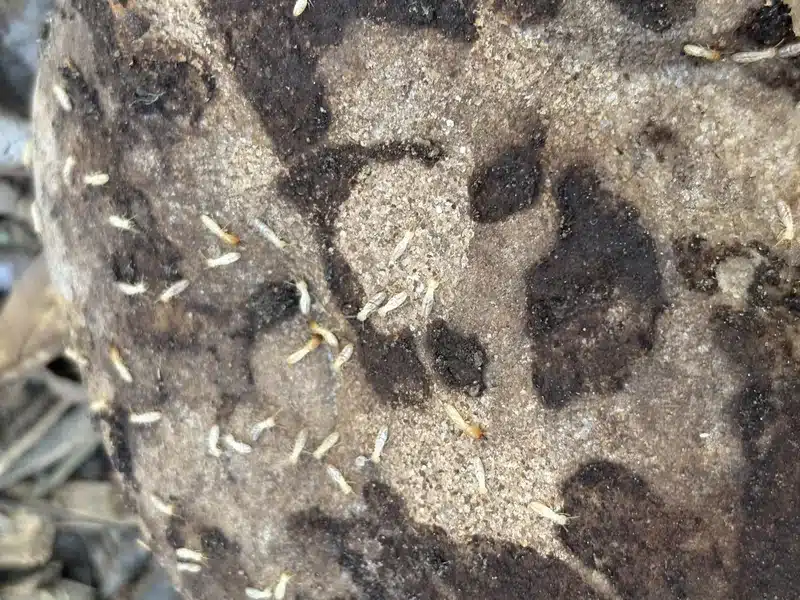When you’re dealing with termites in Northern Virginia, knowing the difference between subterranean termites vs drywood termites can save you thousands of dollars and years of headaches. These two termite types behave completely differently, require different treatments, and cause distinct patterns of damage to your home.
Here in Northern Virginia, we see far more subterranean termites than drywood termites.
Case Study: When a Small Bulge Revealed Major Termite Damage
During my training in Alexandria, we responded to what seemed like a minor issue - homeowners noticed a small bulge in their window sill. What we discovered changed everything I thought I knew about subterranean termite activity and damage patterns.
- Initial sign: A barely visible bulge in the window sill
- What we found: Extensive mud tube networks hidden in the crawlspace
- Extent of damage: Years of structural damage running up foundation walls
- Treatment required: Comprehensive liquid barrier treatment around entire perimeter
This experience taught me why understanding the differences between subterranean and drywood termites is so critical for protecting your biggest investment.

Moisture Requirements: The Key Difference
The biggest difference between subterranean termites vs drywood termites comes down to water. Subterranean termites must stay connected to moisture in the soil to survive.
What does the science say?
According to USFS research, subterranean termites die quickly when humidity drops below 97%. This critical moisture requirement explains why these termites must maintain constant contact with soil and why they build protective mud tubes when foraging above ground.
Drywood termites work completely differently. They live entirely inside dry wood and get their moisture from the wood itself and their own metabolism. They have special organs that help them conserve every drop of water they can find.
This moisture difference explains why we see so many more subterranean termites in Northern Virginia. Our clay-heavy soil and humid climate create perfect conditions for subterranean colonies to thrive underground.
Termite Colony Locations and Foraging Patterns
Subterranean Termite Colonies
Subterranean termites build their main nests underground, usually 0.5 to 6 meters deep. These colonies can house anywhere from 100,000 to over 1 million termites. The workers travel through underground tunnels that can extend up to 150 feet from the main nest.
Because they forage so widely, a single colony can affect multiple homes in a neighborhood. I’ve worked with over 100 customers dealing with termite issues, and it’s common to see several houses on the same street discover termite activity around the same time.
Drywood Termite Colonies
Drywood termites keep things simple. Their entire colony lives inside one piece of wood - maybe a beam, door frame, or piece of furniture. These colonies are much smaller, typically containing just a few thousand termites.
Since they don’t need soil contact, drywood termites can infest any wood in your home. However, they’re much less common in Northern Virginia because our climate doesn’t suit them as well.

| Subterranean Termites | Drywood Termites | |
|---|---|---|
| Colony Location | Underground, 0.5-6 meters deep | Inside wood structures |
| Colony Size | 100,000 - 1+ million | Few thousand |
| Moisture Needs | Requires soil contact | Gets moisture from wood |
| Key Signs | Mud tubes, muddy galleries | Kick-out holes, pellets |
| Best Treatment | Liquid barriers, bait systems | Fumigation, spot treatments |
Identifying Signs: Mud Tubes vs Kick-Out Holes
Subterranean Termite Signs
The clearest sign of subterranean termites is mud tubes. These pencil-thin earthen tunnels run up foundation walls, along joists, and around plumbing penetrations. Termite mud tubes protect the workers as they travel between their underground colony and the wood they’re eating.
Other subterranean termite signs include:
- Hollow-sounding wood when tapped
- Muddy or soil-stained galleries in damaged wood
- Discarded wings near windows and doors during swarm season
- Soft spots or bulges in painted surfaces
That Alexandria job I mentioned earlier showed classic subterranean termite signs. The mud tubes were hidden in the crawlspace, but once we found them, we could trace the damage patterns throughout the affected area.
Drywood Termite Signs
Drywood termites leave completely different calling cards. Instead of mud tubes, you’ll find kick-out holes - tiny pin-sized openings where termites push out their waste pellets. These termite pellets are distinctive six-sided granules that look like tiny coffee grounds.
Key drywood termite indicators include:
- Small piles of pellets beneath kick-out holes
- Clean, smooth galleries that cut across wood grain
- Blistered or peeling paint over infested wood
- Small holes plugged with pellets


Swarming Seasons in Northern Virginia
Timing helps distinguish between subterranean termites vs drywood termites. Subterranean termites swarm in late winter and spring, typically from February through May. According to Penn State Extension, these swarms happen on warm days (above 70 degrees Fahrenheit) after rainfall.
Drywood termites follow a different schedule. Most species swarm in late summer through fall, with flights happening during dusk or dawn. Because drywood termites are less common here, you’re much more likely to see subterranean swarms in Northern Virginia.
If you spot winged termites around your home during spring, they’re probably subterranean termites indicating an established colony nearby.
Damage Patterns and Feeding Behavior
How Subterranean Termites Damage Wood
Subterranean termites prefer soft spring wood and eat along the grain. They leave behind irregular galleries lined with muddy paste. The wood often looks stained or dirty because of the soil particles they bring with them.
These termites work fast because of their large colony size. In severe cases, they can hollow out major structural elements in just 3-5 years. The damage often goes unnoticed until it’s extensive because they leave a thin veneer of wood on the surface.
Drywood Termite Damage Characteristics
Drywood termites create smooth, clean galleries that cut across wood grain. Unlike subterranean termites, they don’t bring soil into their tunnels. Instead, they compact their waste into those distinctive pellets and push them out through kick-out holes.
The damage develops more slowly because drywood colonies are smaller. However, multiple colonies can infest different areas of the same structure, creating widespread but localized damage.

Treatment Methods: Liquid Barriers vs Fumigation
Subterranean Termite Treatments
The most effective treatment for subterranean termites is liquid soil barriers. We apply non-repellent termiticides like Premise or Termidor around the foundation perimeter. These products create a protective zone that eliminates termites when they try to reach your home.
That Alexandria job required extensive liquid treatments because the colony was outside the house and kept sending workers through mud tubes. The liquid barrier approach works well for subterranean termites because they must travel through treated soil to reach food sources.
Another excellent option is Sentricon baiting systems. These stations are placed around your property and contain termite bait that workers carry back to eliminate the entire colony. I’ve helped many customers with Sentricon systems, and they’re particularly effective for long-term protection.
Drywood Termite Treatment Options
Drywood termites require different approaches because they live entirely within the wood. Whole-structure fumigation is often the most thorough option. The entire house is sealed and filled with sulfuryl fluoride gas that penetrates all wood surfaces.
For smaller infestations, spot treatments work well. These might include:
- Drilling and injecting termiticide directly into galleries
- Heat treatments that raise wood temperature to lethal levels
- Microwave or electrogun applications for localized areas
- Borate dust or liquid injections
The key with drywood termite treatment is accurately mapping all infested areas. Missing even one colony means the problem will continue.


Cost and Logistics Considerations
When comparing subterranean termites vs drywood termites, treatment costs and logistics differ significantly. Subterranean termite treatments typically cause minimal disruption to your daily routine. The liquid barrier application happens around the exterior, and you can usually stay in your home throughout the process.
Drywood termite fumigation requires a 2-3 day evacuation while your home is sealed and treated. Heat treatments take 6-12 hours but don’t require evacuation. Spot treatments cause the least disruption but require precise identification of all infested areas.
The good news is that subterranean termite treatments typically last 10-15 years when done properly. Drywood treatments may need monitoring and retreatment if new colonies establish.
Prevention Strategies for Northern Virginia Homes
Prevention approaches differ when dealing with subterranean termites vs drywood termites. For subterranean termites, focus on moisture control:
- Maintain proper drainage around your foundation
- Keep soil-to-wood contact at least 18 inches
- Repair leaky gutters and plumbing
- Ventilate crawl spaces properly
- Remove wood debris and cellulose mulch near the house
Drywood termite prevention centers on blocking entry points:
- Seal cracks and crevices in exterior wood
- Install fine mesh screens over attic and foundation vents
- Paint or varnish exposed wood surfaces
- Inspect secondhand furniture before bringing it inside
- Remove dead tree limbs touching your roof
Essential Termite Prevention Steps
- Moisture Control: Fix leaks promptly, maintain 6-inch clearance between soil and siding, and keep crawl space humidity below 60%
- Soil Protection: Avoid disturbing treated soil within one foot of your foundation
- Professional Consultation: Call your pest control company before installing drainage systems, adding topsoil, or making landscaping changes
- Prevention Measures: Keep firewood away from your home, remove dead tree stumps, and maintain proper grading

Professional Termite Inspection and Detection
Early detection makes a huge difference with both termite types. Professional termite inspections use different techniques for subterranean termites vs drywood termites.
For subterranean termites, we probe around foundations with specialized tools, check for mud tubes in crawl spaces, and test wood for hollowness. The inspection focuses on areas where soil meets wood and moisture accumulates.
Drywood termite detection relies more on finding pellet accumulations, using acoustic devices to detect activity, and sometimes borescope cameras to see inside wood structures. According to UC-IPM research, accurate mapping is essential before any drywood termite treatment begins.
During our standard inspection process, registered technicians check both interior and exterior areas, probe soil around the foundation, and examine crawl spaces or basements for signs of either termite type.
When to Call for Professional Help
Don’t wait if you suspect either type of termite activity. Termite protection programs work best when started before major damage occurs. Early intervention can mean the difference between a standard treatment and expensive structural repairs.
Whether you’re dealing with subterranean termites vs drywood termites, professional treatment provides the most reliable results. DIY approaches rarely address the full scope of termite colonies and often allow problems to worsen while you’re trying home remedies.

Understanding the differences between subterranean termites vs drywood termites helps you recognize problems early and choose the right treatment approach. In Northern Virginia, subterranean termites pose the greatest threat to most homes, but knowing how to spot either type can protect your investment and give you peace of mind.
If you suspect termite activity or want to establish proactive protection for your home, don’t hesitate to reach out. Call us at 703-683-2000 for a thorough inspection and personalized treatment recommendations, or email us at info@bettertermite.com. Our registered technicians have the experience and tools to accurately identify termite types and design effective treatment strategies for your specific situation.
Frequently Asked Questions
What's the main difference between subterranean and drywood termites?
+
The biggest difference is moisture requirements. Subterranean termites must stay connected to soil moisture and build mud tubes to travel, while drywood termites live entirely inside wood and don't need soil contact. This affects everything from where they nest to how they're treated.
Which type of termite is more common in Northern Virginia?
+
Subterranean termites are far more common in Northern Virginia. Our clay soil and humid climate create ideal conditions for subterranean colonies. Drywood termites occasionally arrive in furniture or lumber shipments but don't establish outdoor colonies as easily in our climate.
How can I tell if I have subterranean or drywood termites?
+
Look for different signs. Subterranean termites leave mud tubes on foundation walls and create muddy galleries in wood. Drywood termites create small kick-out holes and leave piles of six-sided pellets that look like coffee grounds. The damage patterns and locations also differ significantly.
Do subterranean and drywood termites require different treatments?
+
Yes, completely different approaches work best. Subterranean termites respond well to liquid soil barriers or baiting systems that target their underground colonies. Drywood termites often need fumigation or spot treatments because they live entirely within the wood structure.
When do termites swarm in Northern Virginia?
+
Subterranean termites typically swarm from February through May on warm days after rain. Drywood termites have different timing, usually swarming in late summer through fall during dusk or dawn hours. Spring swarms in Northern Virginia are almost always subterranean termites.
Which type causes damage faster?
+
Subterranean termites typically cause damage faster because their colonies are much larger, sometimes containing over a million individuals. They can hollow out structural elements in 3-5 years. Drywood colonies are smaller but can still cause significant localized damage over time.
Can I have both types of termites at the same time?
+
It's possible but uncommon in Northern Virginia. While subterranean termites might be active around your foundation, drywood termites could theoretically infest furniture or attic areas. However, our climate heavily favors subterranean termites over drywood species.
How much does treatment cost for each type?
+
Treatment costs vary based on the size of your home and extent of infestation. Subterranean termite liquid barriers typically cost less and cause minimal disruption. Drywood termite fumigation is more expensive and requires temporary evacuation, while spot treatments cost less but require precise detection of all colonies.
With five years of hands-on experience in the pest control industry, George Schulz is a registered technician with the Virginia Pest Management Association and a proud third-generation professional in a family business that's been protecting homes for over 57 years. He manages and trains a team of service pros while also leading internal research efforts—recently spearheading a deep-dive review of thousands of documents on pest control materials to hand-pick the most kid and pet friendly, most effective solutions tailored specifically for homes in the DC metro area.
